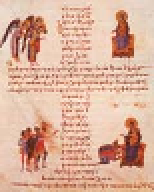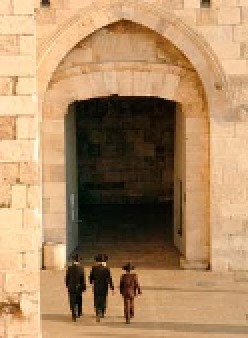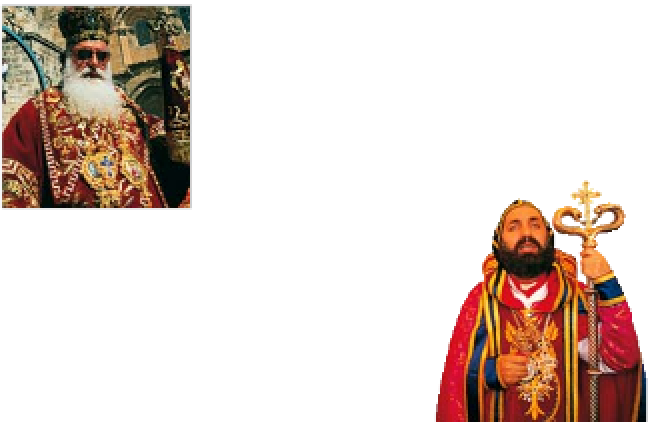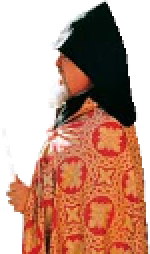Travel Reference
In-Depth Information
Museum of the
Greek Orthodox
Patriarchate
7
Greek Orthodox Patriarchate Road.
Map
3B3.
Tel
(02) 628 2048.
l
#
8am-3pm Mon-Sat.
&
Greek
Catholic Patriarchate
Tel
(02) 627
l
1968.
#
8am-noon Mon-Sat.
&
Omar in AD 638,
granting the Greek
Orthodox Church
custody Jerusalem's
holy places.
The nearby
Greek
Catholic Patriarchate
,
on the street of the
same name that leads
towards Jaffa Gate,
has a small museum
containing a collec-
tion of religious vestments
and liturgical objects.
Jaffa Gate
8
Map
3 B4.
@
1, 13, 20.
great size, the
entrance tunnel is
narrow; it is also
L-shaped - both
measures meant
to slow attackers.
It was constructed
during the reign
of Suleyman the
Magnificent - an
exact date of 1538
is given in a dedica-
tion within the arch on the
outside of the gate. The breach
in the wall through which cars
now pass was made in 1898,
in order to allow the visiting
Kaiser Wilhelm II of Germany
to enter the city in his carriage.
Immediately inside the gate,
set into the wall behind some
railings on the left, are two
graves. Tour guides like to
tell how these belong to
Suleyman's architects, exe-
cuted because they failed to
incorporate Mount Zion within
the city walls. An alternative
legend has it that they were
killed to prevent them ever
building such grand walls for
anyone else. In fact, they are
the graves of a prominent
citizen and his wife.
Jaffa Gate is one of the
places where visitors can
access the ramparts to walk
along the city walls
(see
pp142-3)
. To the Arabs this
gate is known as Bab el-Khalil,
from the Arabic name for
Hebron (El-Khalil). The old
road to the town started here.
Codex from the Greek
Patriarchate Museum
Tucked away in the back alleys
of the Christian Quarter, this
museum houses a collection
of ecclesiastical items that
includes icons, embroidered
vestments, mitres, chalices
and filigree objects. It also has
a fine array of archaeological
finds. Of most interest are
two white-stone sarcophagi
found at the end of the 19th
century in a tomb near the
present-day King David
Hotel. They are considered
to belong to the family of
Herod the Great
(see p120)
,
and are covered in wonderfully
elaborate floral decoration,
which represents some of the
finest Herodian-era funerary
art ever found. The museum
also displays Crusader objects,
including a 12th-century carved
capital from Nazareth, and
artifacts found in the tomb of
Baldwin I (king of Jerusalem,
1100-18) in the Church of
the Holy Sepulchre.
Among a collection of his-
torical firmans (imperial edicts),
is one that purports to have
been issued by the caliph
This is the busiest of the seven
Old City gates. It is the main
gate for traffic and pedestrians
coming from modern West
Jerusalem. Despite the gate's
Jaffa Gate, the main way into the
Old City from West Jerusalem
EASTERN CHRISTIANITY AND THE PATRIARCHATES
There are no fewer than 17 churches represented in Jerusalem, a result
of a great many historical schisms. As Christianity spread in the 2nd and
3rd centuries, patriarchates were established in Alexandria, Antioch,
Constantinople, Jerusalem and Rome. Their heads, the patriarchs, claimed
lineage from the Apostles, which gave them the authority to pronounce
on correct doctrine. The first major schism came when the Council of
Chalcedon (
( D 451) proclaimed the dual “divine and human” nature
of Christ, and in so doing estranged the Armenian, Ethiopian,
Coptic and Syrian churches from the
Roman Catholic and mainstream
Orthodoxy. Eastern and Western
Christianity split in 1054, when
the Eastern churches refused
to acknowledge the primacy of the Pope and the
Roman church. Today there are four patriarchs
(a position akin to that of an archbishop) resi-
dent in Jerusalem: those of the Greek Orthodox,
Armenian, Greek Catholic and Latin (Roman
Catholic) churches. The Ethiopians and Copts
have a building called a patriarchate, but
without the figure of the patriarch.
Jerusalem's Greek
Orthodox Patriarch
Syrian Orthodox priest
Armenian priest
For hotels in this area see p256


















